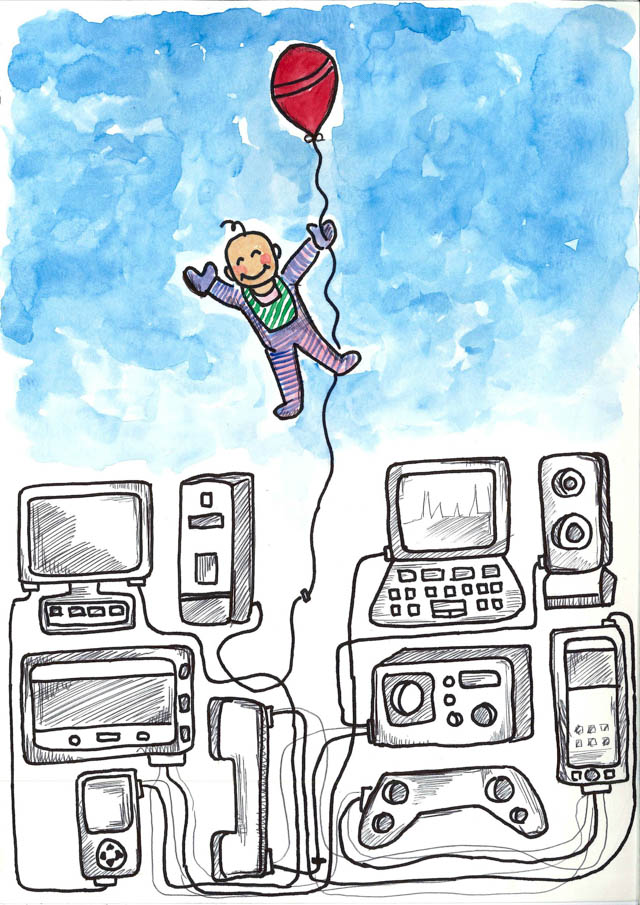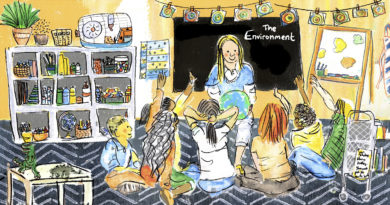How Hi-Tech Would You Like Your Babies to Be?

What is it like to grow up without technology?
I would like to tell you all a small story. Newly married, when I first moved to Europe with my husband, I was still adjusting to a new life, new country and everything new around me. Around this time, I met an Indian couple who had lived in the Netherlands for more than forty years. To us and to many other Indians who moved there around the same time, they became newfound parents in a strange country that we were all still exploring.
In one of our meetings, the wife began telling me what it had been like to move to Europe 40 years earlier. Just before she left India, her mother told her, “Write me a letter once a week; even if it’s just a line: ‘Amma, I am good.’ “ Her weekly letters would take many weeks to reach her mother. But she continued the practice for many, many years to tell her mother that: she had found a job; she was learning a new language; they had had more kids; and all the details of her life in Holland. She then looked at me and said, “You kids have grown up with technology. You call your mom just to ask about recipes and remedies. We had neither the luxury nor the facilities. So even if you don’t call her everyday, remember to just text her: ‘Amma, I am good.’”
Technology today is not seen as a luxury. It has become a necessary part of our everyday life. We have grown from the era of posting letters to sending emails. From using landlines to mobile phones, then high-end touch-screen phones and touch-screen tablets.
The good in technology
But are there only good things about letting your babies and children grow up with technology? Let’s begin by looking at what is, indeed, good. We can all agree that one of the best things about technology is the ability to stay connected. When I first moved so far away from my family, I would text and call my parents and in-laws, or Skype with them. Today we Viber, we Whatsapp, send voice notes and video messages as our kids reach their growth milestones – rolling over, taking their first steps, and saying their first words. Over the years, the devices and the number of apps have only increased, helping us all stay in touch with friends and family across the globe. Just like adults, the kids have a virtual meet-up with their grandparents and cousins and other extended family living in another city or country, and one can feel the sense of emotional bonding when they really meet in person and connect with each other.
Setting limits for young children
But as new parents most of us question how much TV/tablet time children should have in a day. The Swiss parenting counsellors Mütter- und Vaterberatung advise that a child shouldn’t be allowed more than 15 to 20 minutes in a day. This applies to babies who are more than six months old up to children aged four. They also recommend that the parents choose the simplest of apps for young children, like clicking to find colours or names of animals, or watching nursery rhymes or reading a fairy tale together. Also, anything that’s fast both visually and aurally shouldn’t be shown to this age group.
I wanted to stick to these boundaries, but it was somehow felt like too little time, and it was also difficult. So I decided to let my girls, three-and-a-half and 18 months old, watch for a little longer. Just like we do a story time at night reading from books, they also have their stories and rhymes time with the television. This has actually helped our girls learn rhymes not just in English but also in our mother tongue Tamil. They can relate to the words and repeat them fluently, with hand motions.
Earlier I would sit with my daughters while they watched these rhymes, but then as I unknowingly let them watch for longer while I carried on with other work, I noticed that my older daughter had taught herself how to use the mouse. She now plays one video of her choice and the second of her sister’s choosing, clicking on the YouTube videos that show up after a rhyme or story finishes.
Of course as parents we have to take care that they do not click on any adult content. The safety mode that I leave on all the time in all the devices helps me ensure this.
But technology can inspire learning
To give an example of their learning from the television, it was around Christmas that our girls first got introduced to the Gruffalo on BBC. From then on they’ve watched the programme many times and have fallen in love with the series, so we bought them the Gruffalo books. Now when my older daughter (who can’t read words or sentences yet) turns over each page of the book, she can easily seem as if she is reading, pausing and narrating the story just as she saw it on television.
It gets even better with touch-screen use. Most kids over one year of age really don’t need to be taught to use these screens – they pick it up fast. Both Android and Apple stores are flooded with games and learning apps with divisions by age. At toddler age you have apps to learn the names and sounds of the animals, names of shapes, vegetables, and fruits. There are puzzles to connect the right letter alphabet to its corresponding shape, or colouring, dressing, and feeding your favourite doll, and so on. For older kids there are apps that teach mathematics, science and other subjects in a fun and engaging way.
The downside
But it’s also true that often as parents we lose track of how long the child should be playing or using the device, and perhaps we depend on the devices too much. The other day while returning from my daughter’s playgroup, I saw a mother silencing her crying baby by showing him the videos of Peppa Pig on her mobile. The child became quiet in seconds. And recently in one of the discussion forums on Facebook here in Switzerland, a mother was taking suggestions for videos she should load into her tablet for a long-distance flight with her two-year-old, to keep her child engaged.
Furthermore, we sometimes unknowingly expose our kids to such long hours of technology that we later regret introducing it at all in the first place, like switching on the television or their favourite videos during mealtimes. For some kids it might be all right, as it doesn’t affect their eating in any way. But for those kids who are already picky eaters, it worsens their eating habits. They also begin picking what to watch with their meals and in turn are keener to know what’s on TV for them than what is on their plate.
Passive entertainment and neglected motor skills
Even though children learn much faster with the electronic devices, this results in passive entertainment if left for long hours and they lose interest in real activities like colouring, painting, and especially writing. It is easier for me to have my three-and-a-half-year-old daughter write an “A” or colour within a box on a touch screen pad than to get her to use a pencil. She does like colouring and painting on paper too! It is comparable to the difference between handwriting and typing.
How useful is it to let your child touch write or type than to actually hold a pencil in hand and draw her first letter of the alphabet? I remember when I first learned to write the alphabet in Tamil, I enjoyed drawing the characters rather than really writing them. I shall continue with my efforts to make my child do her pre-writing exercises – drawing the straight, sleeping and slanting lines. While it takes quite a while before kids understand and use these motor skills with ease, typing – whether on a touch screen or pressing keys – seems to come much faster.
As always, moderation is key.
As I was working on this article, my older child learned to make and end Skype calls and take pictures while chatting with her grandparents. As a parent I’m pleased to see my girls recognizing their grandparents and relatives when they video chat with them or surf through family photographs and videos in my tablet. It’s wonderful to see them grow together sharing the tablet between them to learn new songs and stories and a new word.
But at the same time, I also feel a sense of guilt, wondering if I am slowing down their motor skill development with such amounts of exposure to technology. They haven’t yet reached the stage where they can read from the tablet. They love to hold books and enjoy their story time. I take them to the library every Wednesday. I make them pick the books they like. This may be the age of digital reading, but to me it is a better experience to feel and smell the paper. It makes sense to be surrounded by real books as objects in our real world.
Somewhere we need to draw a line for our technology use. We make time for reading, a time for play, and times to eat. If we also declare a set time for these tech toys, it will balance their learning in all forms. They can then grow into better minds with technology than they would without it.
By Keerthana Nagarajan
Keerthana lives with her husband and two little girls in Zurich. She is currently freelancing with swissinfo, covering Indian-Swiss stories. Keerthana worked previously in the Netherlands at Radio Netherlands Worldwide, covering South Asia news, and CNN’s sister concern in India CNN-IBN, a 24-hour news channel. Here’s the link to all her published content: http://keerthananagarajan.blogspot.in
Illustration by Sharanya Mageshwaran
Sharanya Mageshwaran is a stay-at-home mom of a very naughty three-year-old who speaks better German than her mother does. Before moving to Zurich, Sharanya was a pharmaceutical research scientist in India. She loves painting and sketching with fauvist expressionist abstract themes. More of her artwork can be see here: http://somelightandcolor.blogspot.ch/




Very good read Keerthana. ‘Amma I am good.’ A nice reminder. What’s the use of technology if we forget to put it to good use and strengthen the bonds we have with our loved ones.
And in terms of kids, discipline starts with us, as to how much time we allow ourselves in front of screens (just when they are around